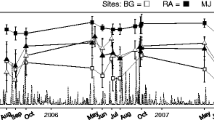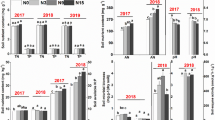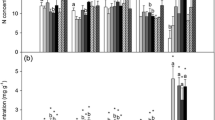Abstract
In order to determine whether nitrogen (N) or phosphorus (P) limits aboveground plant growth in peatlands in Alberta, we fertilized one bog, two fens, and two marshes with N and P at a ratio of 7∶1 (Redfield ratio of these two elemental nutrients in aquatic plants) as well as with water without either fertilizer in 1994. The response of aboveground plant production to N or P was species-specific and varied among the sites. In the bog,Smilacina trifolia, a herb, showed significant increases in net primary production (NPP) after fertilization with N plus water and the addition of water, whileAndromeda polifolia only showed significant increases in NPP after fertilization with N plus water.Ledum groenlandicum, an ericaceous shrub, showed significant decreases in NPP after additions of N plus water, P plus water, and water, whileOxycoccus quadripetalus, another ericaceous shrub, also showed significant decreases of NPP after additions of N plus water and water.Sphagnum fuscum (moss) NPP increased significantly after the additions of water and decreased significantly after the additions of N plus water and P plus water. In the fens and marshes, onlyCarex spp. in the lacustrine sedge fen showed a significant increase in NPP after the addition of N. Vascular NPP (shrubs and herbs combined) did not increase significantly in any of the five peatlands. Total NPP (moss, herb, and shrub strata combined) increased significantly only in the bog after the addition of water due to the dominance of the moss stratum in that site. In the bog, moss growth was limited by water, and herb and shrub growth responses to N and P fertilization were species-specific. Neither N nor P limited aboveground plant production in the fens and marshes.
Similar content being viewed by others
Literature Cited
Aerts, R., B. Wallén, and N. Malmer. 1992. Growth-limiting nutrients inSphagnum-dominated bogs subject to low and high atmospheric nitrogen supply. Journal of Ecology 80:131–140.
Barko, J. W. and R. M. Smart. 1986. Sediment-related mechanisms of growth limitations in submersed macrophytes. Ecology 67: 1328–1340.
Barko, J. W. and R. M. Smart. 1978. The growth and biomass distribution of two emergent freshwater plants,Cyperus esculentus andScirpus validus, on different sediments. Aquatic Botany 5:109–117.
Bartsch, I. 1994. Effects of fertilization on growth and nutrient use byChamaedaphne calyculata in a raised bog. Canadian Journal of Botany 72:323–329.
Bayley, S. E., D. H. Vitt, R. W. Newbury, K. G. Beaty, R. Behr, and C. Miller. 1987. Experimental acidification of aSphagnum-dominated peatland: First year results. Canadian Journal of Fisheries and Aquatic Sciences 44:194–205.
Bayley, S. E., J. Zoltek Jr., A. J. Hermann, T. J. Dolan, and L. Tortora. 1985. Experimental manipulation of nutrients and water in a freshwater marsh: Effects on biomass, decomposition, and nutrient accumulation. Limnology and Oceanography 30:500–512.
Bernard, J. M. and E. Gorham. 1978. Life history aspects of primary production in sedge wetlands. p. 39–51.In R. E. Good, D. F. Whigham, and R. L. Simpson (eds.) Freshwater Wetlands: Ecological Processes and Management Potential. Academic Press, New York, NY, USA.
Bridgham, S. D., J. Pastor, J. A. Janssens, C. Chapin, and T. J. Malterer. 1996. Multiple limiting gradients in peatlands: a call for a new paradigm. Wetlands 16:45–65.
Chapin III, F. S. 1988. Ecological aspects of plant mineral nutrition. Advances in Plant Nutrition 3:161–191.
Chapin III, F. S. 1980. The mineral nutrition of wild plants. Annual Review of Ecology and Systematics 11:233–260.
Chapin III, F. S. 1974. Morphological and physiological mechanisms of temperature compensation in phosphate absorption along a latitudinal gradient. Ecology 55:1180–1198.
Chapin III, F. S., P. M. Vitousek, and K. VanCleve. 1986. The nature of nutrient limitations in plant communities. American Naturalist 127:48–58.
Chapin III, F. S., D. A. Johnson, and J. D. McKendrick. 1980. Seasonal nutrient movements in various plant growth forms in an Alaskan tundra: Implications for herbivory. Journal of Ecology 68:189–210.
Clymo, R. S. 1987. Interactions ofSphagnum with water and afr. p. 513–528.In T. C. Hutchinson and K. M. Mleema (eds.) Effects of Atmospheric Pollutants on Forests, Wetlands, and Agricultural Ecosystems. Springer-Verlag, Berlin, Germany.
Clymo, R. S. 1970. The growth ofSphagnum: methods of measurement. Journal of Ecology 58:13–49.
Cole, J. A. 1988. Assimilatory and dissimilatory reduction of nitrogen and ammonia. p. 281–329.In Cole, J. A. and S. J. Ferguson (eds.) The Nitrogen and Sulphur Cycles. Cambridge University Press. Cambridge, England.
Environment Canada. 1982. Canadian Climate Normals, 1951–1980, Temperature and Precipitation, Prairie Provinces. Canadian Climate Program, Ottawa, Ontario, Canada.
Firestone, M. K. 1982. Biological denitrification. p. 289–326.In Stevenson, F. J. (ed.) Nitrogen in Agricultural Soils. American Society of Agronomy, Madison, WI, USA.
Goodman, G. T. and D. F. Perkins. 1968. The role of mineral nutrients inEriophorum communities. III. Growth responses to added inorganic elements in twoEriophorum vaginatum communities. Journal of Ecology 56:667–683.
Grime, J. P. 1977. Evidence for the existence of three primary strategies in plants and its relevance to ecological and evolutionary theory. American Naturalist 111:1169–1194.
Grime, J. P. and R. Hunt. 1975. Relative growth rate: Its range and adaptive significance in a local flora. Journal of Ecology 63:393–422.
Hayward, P. M. and R. S. Clymo. 1983. The growth of someSphagnum: experiments on, and stimulation of, some effects of light flux and water table depth. Journal of Ecology 71:845–863.
Hillman, G. R., J. D. Johnson, S. K. Takyi. 1990. The Canada-Alberta Wetlands Drainage and Improvement for Forestry Program. Forestry Canada/Alberta Forestry, Lands and Wildlife, Edmonton, Alberta, Canada. Project #1413-1417-86.
Kadlec, R. H. 1987. The use of peatlands for wastewater treatment. p. 213–218.In C. D. A. Rubec and R. P. Overend (eds.) Symposium ’87 Wetlands/Peatlands. Ottawa, Ontario, Canada.
Korner, H., K. Frunzke, K. Dohler, and W. G. Zumft. 1987. Immunochemical patterns of distribution of nitrous oxide reductase (cytochromecd1) among denitrifying pseudomonads. Archiv für Mikrobiologie 148:20–24.
Lechowicz, M. J. and G. R. Shaver. 1982. A multivariate approach to the analysis of factorial fertilization experiments in Alaskan arctic tundra. Ecology 64:1029–1038.
Li, Y. and D. H. Vitt. 1997. Patterns of retention and utilization of aerially deposited nitrogen in boreal peatlands. Écoscience 4:106–116.
Loach, K. 1968. Relations between soil nutrients and vegetation in wet-heaths. II. Nutrient uptake by the major species in the field and in controlled condition. Journal of Ecology 56:117–127.
Mitsch, W. J. and J. G. Gosselink. 1993. Wetlands, 2nd edition. Van Nostrand Reinhold, New York, NY, USA.
Munger, J. W. and S. J. Eisenreich. 1983. Continental-scale variation in precipitation chemistry. Environmental Science and Technology 17:32A-42A.
Myrick, R. H. 1993. Air quality monitoring data summary for Alberta 1991. Environmental Quality Monitoring Branch, Edmonton, Alberta, Canada. Technical Report Series No. 93-1b.
Neely, R. K. and C. B. Davis. 1985. Nitrogen and phosphorus fertilization ofSparganium eurycarpum Engelm. andTypha glauca Godfr. stands. I. Emergent plant production. Aquatic Botany 22:347–361.
Packer, J. G. 1983. Flora of Alberta by E. H. Moss, 2nd edition. University of Toronto Press, Toronto, Ontario, Canada.
Press, M. C., S. J. Woodin, and J. A. Lee. 1986. The potential importance of an increased atmospheric nitrogen supply to the growth of ombrotrophicSphagnum species. New Phytologist 103:45–55.
Reader, R. J. 1978. Primary production in northern bog marshes. p. 53–63.In R. E. Good, D. E. Whigham, and R. L. Simpson (eds.) Freshwater Wetlands: Ecological Processes and Management Potential. Academic Press, New York, NY, USA.
Reinikainen, A. and T. Lindholm. 1980. Fertilization experiments on the Laaviosuo mire-ecosystem study area. Lammi Notes 4:22–27.
Rochefort, L. 1987. Biological effects of wet acid deposition on peatland bryophytes. M.Sc. Thesis. University of Alberta, Edmonton, Alberta, Canada.
Rochefort, L. and D. H. Vitt. 1988. Effects of simulated acid rain onTomenthypnum nitens andScorpidium scorpioides in a rich fen. The Bryologist 91:121–129.
Rochefort, L., D. H. Vitt, and S. E. Bayley. 1990. Growth, production, and decomposition dynamics ofSphagnum under natural and experimentally acidified conditions. Ecology 71:1986–2000.
SAS Institute Inc. 1989. SAS/STAT Release 6.08 Edition. Cary, NC, USA.
Schulze, E. D. and F. S. Chapin III. 1987. Plant specialization to environments of different resource availability. p. 120–148.In E. D. Schulze and H. Zwolfer (eds.) Potentials and Limitations of Ecosystem Analysis. Springer-Verlag, Heidelberg, Germany.
Schwartz, L. N. and G. K. Gruendling. 1985. The effects of sewage on a Lake Champlain wetland. Journal of Freshwater Ecology 3:35–46.
Shaver, G. R. and W. D. Billings. 1975. Root production and root turnover in a wet tundra ecosystem, Barrow Alaska. Ecology 56:401–409.
Shaver, G. R. and E. S. Chapin III. 1980. Response to fertilization by various plant growth forms in an Alaskan tundra: Nutrient accumulation and growth. Ecology 61:662–675.
Simms, E. L. 1987. The effects of nitrogen and phosphorus addition on the growth, reproduction, and nutrient dynamics of two ericaceous shrubs. Oecologia 71:541–547.
Sjörs, H. 1991. Phyto- and necromass above and below ground in a fen. Holarctic Ecology 14:208–214.
Thormann, M. N. and S. E. Bayley. 1997a. Aboveground net primary production along a bog-fen-marsh gradient in southern boreal Alberta, Canada. Écoscience 4:374–384.
Thormann, M. N. and S. E. Bayley. 1997b. Decomposition along a fen—marsh peatland gradient in southern boreal Alberta, Canada. Wetlands 17:123–137.
Vasander, H. 1982. Plant biomass and production in virgin, drained and fertilized sites in a raised bog in southern Finland. Annales Botanici Fennici 19:103–125.
Verhoeven, J. T. A. and M. B. Schmitz. 1991. Control of plant growth by nitrogen and phosphorus in mesotrophic fens. Biogeochemistry 12:135–148.
Wallén, B. 1992. Methods for studying below-ground production in mire ecosystems. Suo 43:155–163.
Wetzel, R. G. 1983. Limnology. W. B. Saunders Company, Philadelphia, PA, USA.
Zar, J. H. 1984. Biostatistical Analyses, 2nd edition. Prentice Hall, Englewood Cliffs, NJ, USA.
Author information
Authors and Affiliations
Rights and permissions
About this article
Cite this article
Thormann, M.N., Bayley, S.E. Response of aboveground net primary plant production to nitrogen and phosphorus fertilization in peatlands in southern boreal Alberta, Canada. Wetlands 17, 502–512 (1997). https://doi.org/10.1007/BF03161516
Received:
Revised:
Accepted:
Issue Date:
DOI: https://doi.org/10.1007/BF03161516




